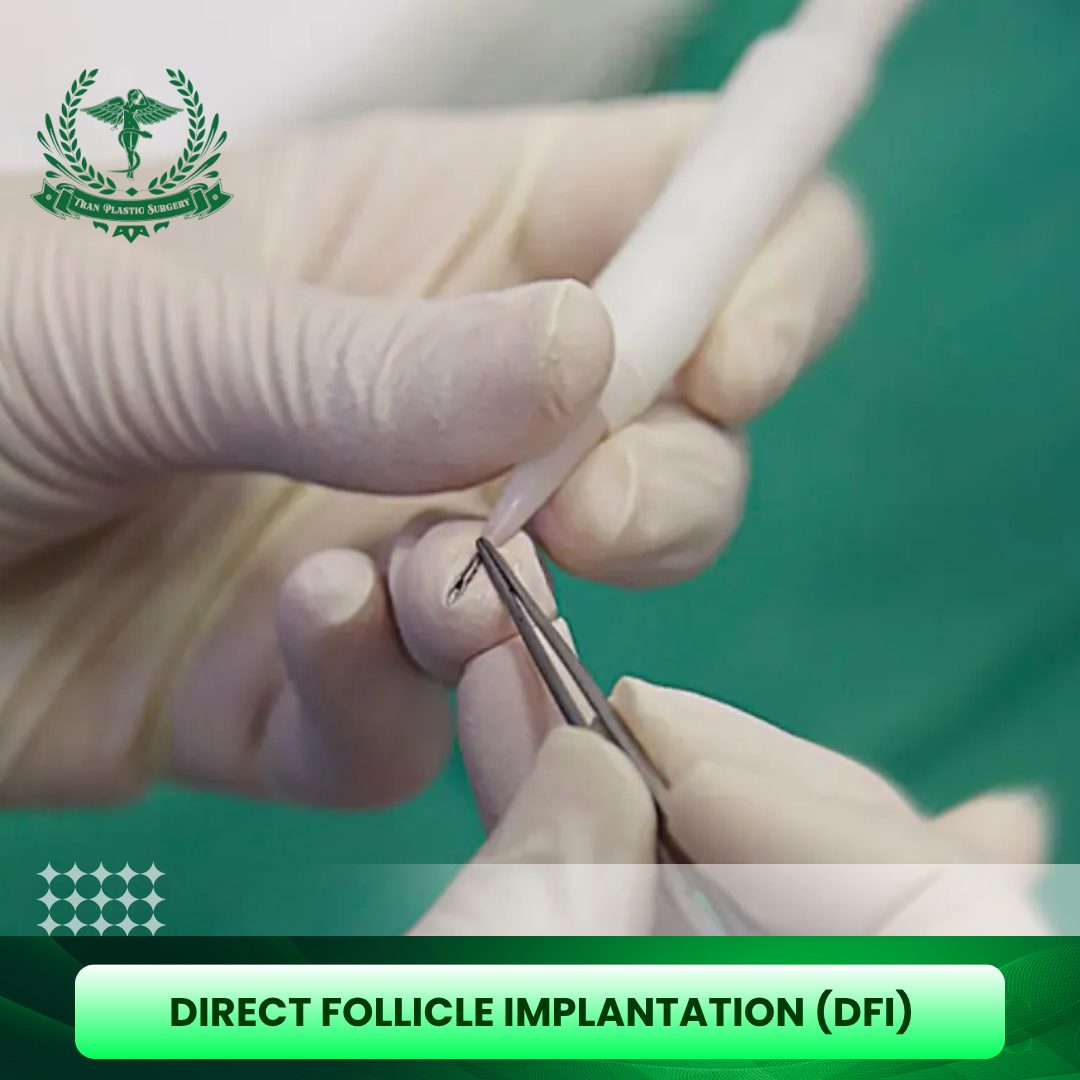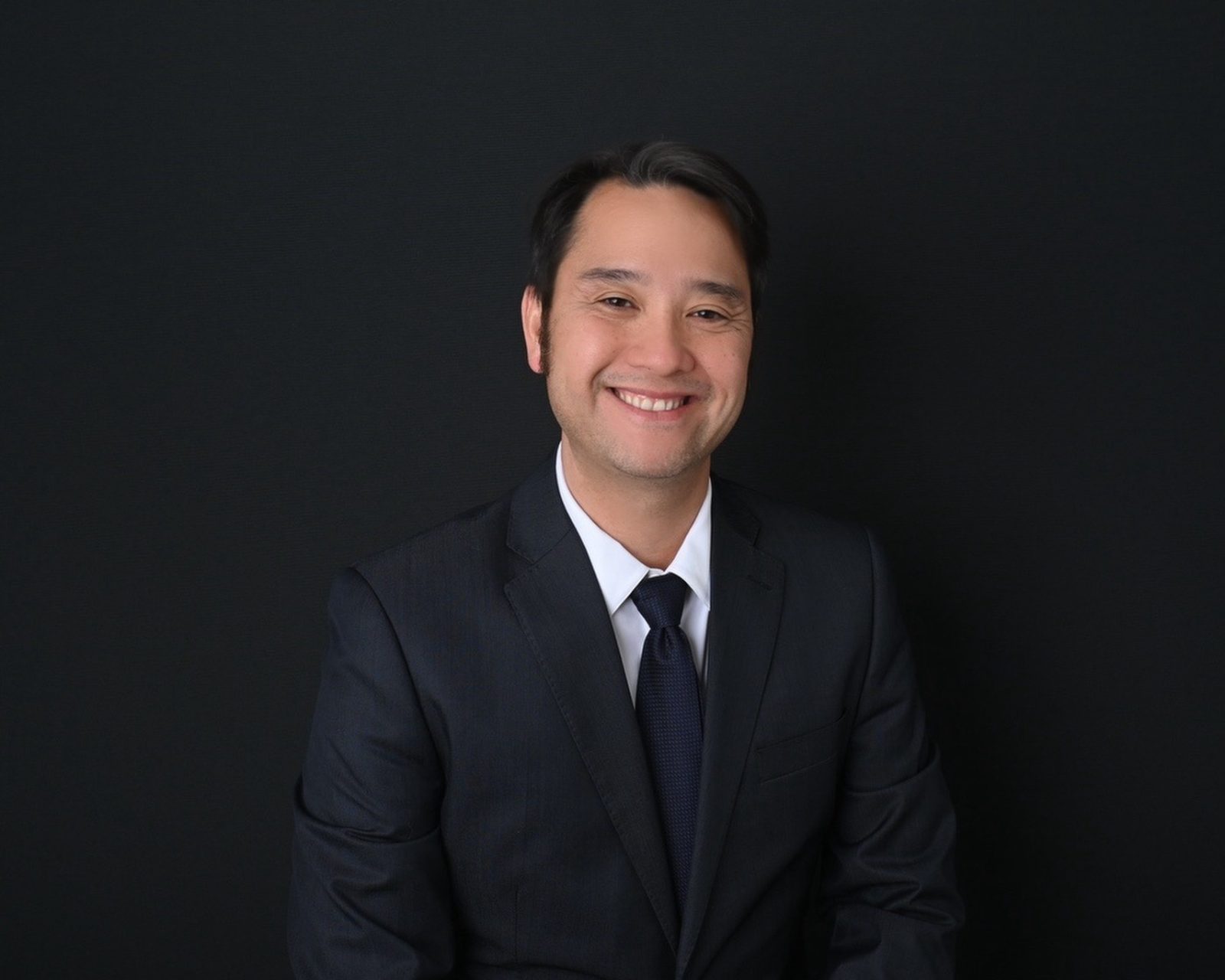Direct Follicle Implantation (DFI), also known as Direct Hair Implantation (DHI), is revolutionizing hair restoration with its precision and speed. Using a special implanter pen, DFI allows surgeons to place each hair follicle directly into the scalp with no cuts, no channels, just natural-looking results and faster recovery.
In this guide, we’ll break down how DFI works, its real benefits, cost, recovery timeline, and insights from Dr. Tuan Tran of Tran Plastic Surgery, one of the leading experts in modern hair transplantation.
Table of Contents
ToggleWhat is Direct Follicle Implantation (DFI)?
Direct Follicle Implantation is an evolution of the FUE (Follicular Unit Extraction) technique. Instead of creating slits or channels in the scalp before graft placement, DFI uses a specialized implant pen (often called the Choi Pen) to perform both site creation and implantation simultaneously.
This innovation allows surgeons to control:
- Angle of implantation
- Depth of the follicle
- Direction of hair growth
As a result, patients benefit from natural hairlines and higher density, with reduced trauma to both the grafts and scalp.
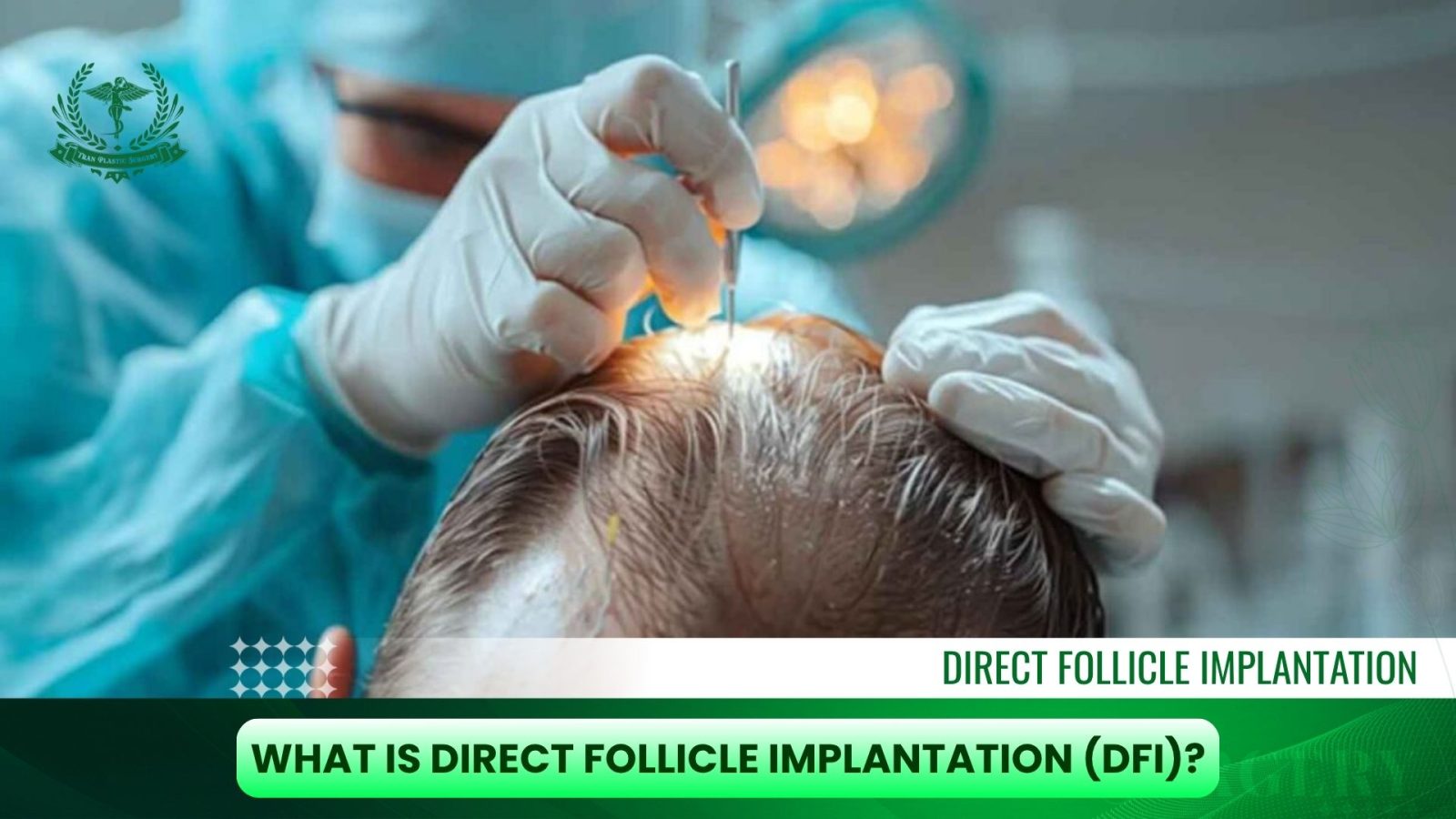
Read more:
How Direct Follicle Implantation Works
The DFI procedure typically involves the following steps:
Step #1: Extraction
- Hair follicles are extracted one by one from the donor area (usually the back or sides of the head).
- The follicles are carefully preserved in a special solution to maintain viability.
Step #2: Preparation
- Extracted follicles are loaded into the DFI implanter pen.
- Unlike other methods, no pre-made incisions or channels are needed.
Step #3: Implantation
- Using the pen, the surgeon directly implants follicles into the balding or thinning areas.
- Each graft is placed at a precisely controlled angle, depth, and direction to mimic natural hair growth.
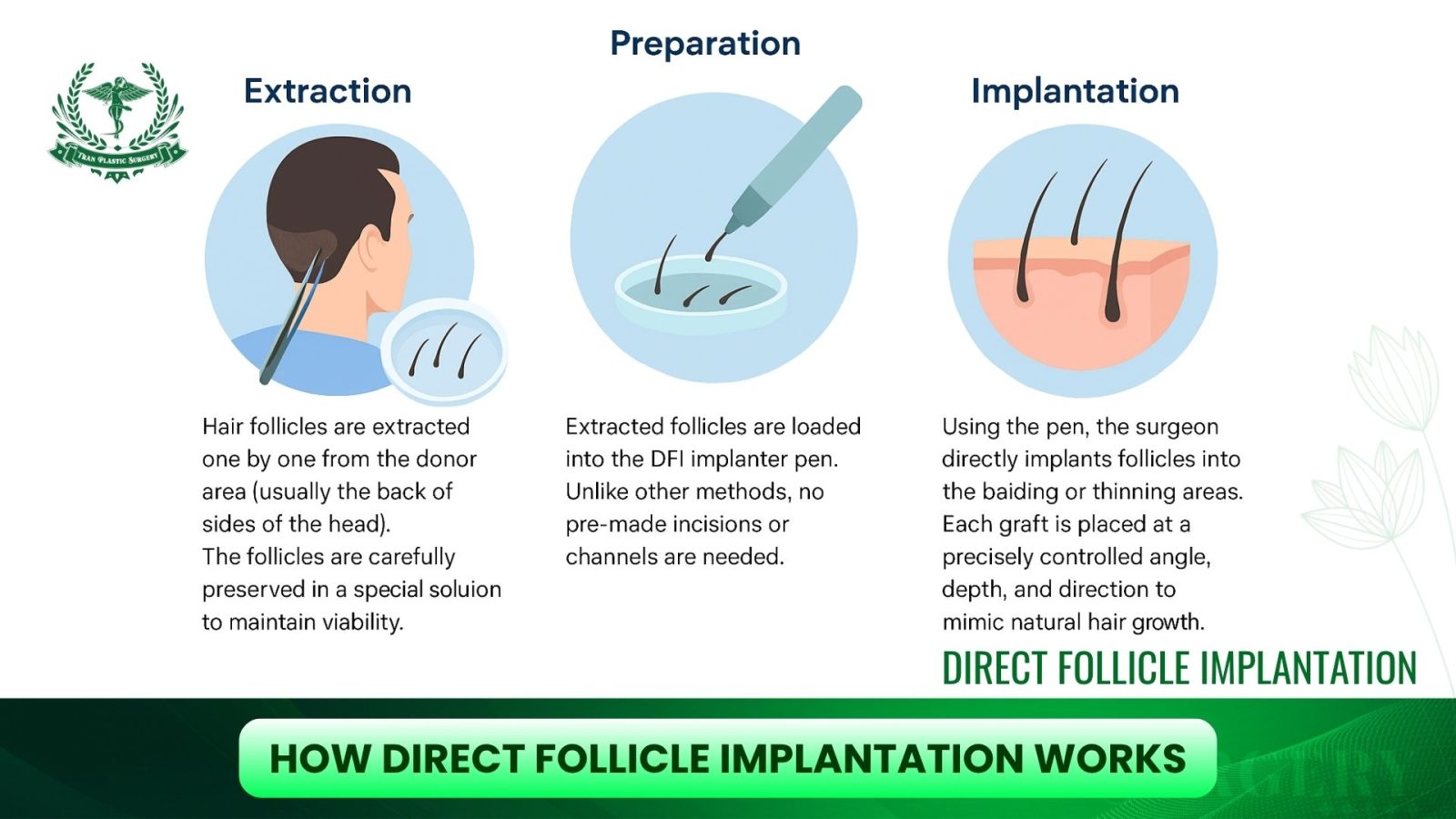
Benefits of Direct Follicle Implantation
Direct Follicle Implantation has become one of the most sought-after hair restoration techniques in recent years, largely because it resolves many of the challenges that patients faced with older procedures like FUT (Follicular Unit Transplantation) and even standard FUE (Follicular Unit Extraction). By using a specialized implant pen, DFI combines surgical precision with patient comfort, resulting in highly natural and lasting outcomes. Below are the key advantages explained in detail:
1. Natural, Lifelong Results
One of the biggest concerns for patients undergoing hair restoration is achieving a natural look. Unlike outdated methods that sometimes left a “pluggy” or uneven appearance, DFI allows the surgeon to control the angle, depth, and direction of each follicle during implantation. This level of precision replicates the natural growth pattern of hair, ensuring that the new hairline blends seamlessly with existing strands. For many patients, especially those with frontal hairline recession, this natural appearance is a game-changer.
2. Exceptional Graft Survival Rate (95–98%)
With traditional methods, hair follicles often spend longer outside the scalp and may be over-handled during dissection and implantation. This increases the risk of follicle trauma and reduces survival rates. In contrast, DFI minimizes handling because follicles are loaded directly into the Choi Implanter Pen and implanted immediately. This dramatically reduces the time grafts remain outside the body, helping survival rates reach 95–98% significantly higher than most conventional approaches.
3. No Scalpels, Stitches, or Visible Scars
DFI is a minimally invasive procedure. There is no need for surgical cuts, sutures, or extensive incisions. Instead, micro-sized implanter tools allow for follicle insertion without prior channel creation. Patients benefit from:
- Reduced bleeding during surgery.
- Minimal scarring that is virtually invisible, even with short hairstyles.
- Faster wound healing compared to FUT, which leaves a linear scar, or standard FUE, which can leave small punch marks.
4. High-Density Packing for Fuller Hairlines
Another major benefit of DFI is the ability to achieve dense packing meaning more follicles can be implanted per square centimeter. This is especially crucial for restoring the frontal hairline and crown areas, where density is essential for a youthful, voluminous look. With precise placement, DFI allows surgeons to implant up to 50–60 follicles per cm², something that is much harder to achieve with older methods.
5. Faster Recovery and Less Discomfort
Because the technique is minimally invasive, patients typically recover much quicker. Most can return to daily activities within just a few days, whereas FUT may require weeks of downtime. Post-surgery swelling, discomfort, and redness are also significantly reduced. Many patients report resuming office work or light exercise almost immediately after the procedure, which makes DFI appealing for busy professionals.
6. Long-Lasting, Permanent Outcomes
The follicles selected for transplantation are usually taken from the back or sides of the head, areas that are genetically resistant to DHT (dihydrotestosterone), the hormone responsible for male pattern baldness. This means once transplanted, the follicles continue to grow naturally for a lifetime. Combined with high survival rates, DFI provides patients with permanent results that rarely require repeat procedures.
7. Confidence Boost and Psychological Benefits
Beyond the medical and technical advantages, one of the most important benefits of DFI is the emotional transformation patients experience. A restored hairline often improves self-confidence, enhances personal and professional interactions, and reduces the anxiety associated with hair loss. For many, this procedure represents not just a cosmetic change, but a genuine improvement in quality of life.
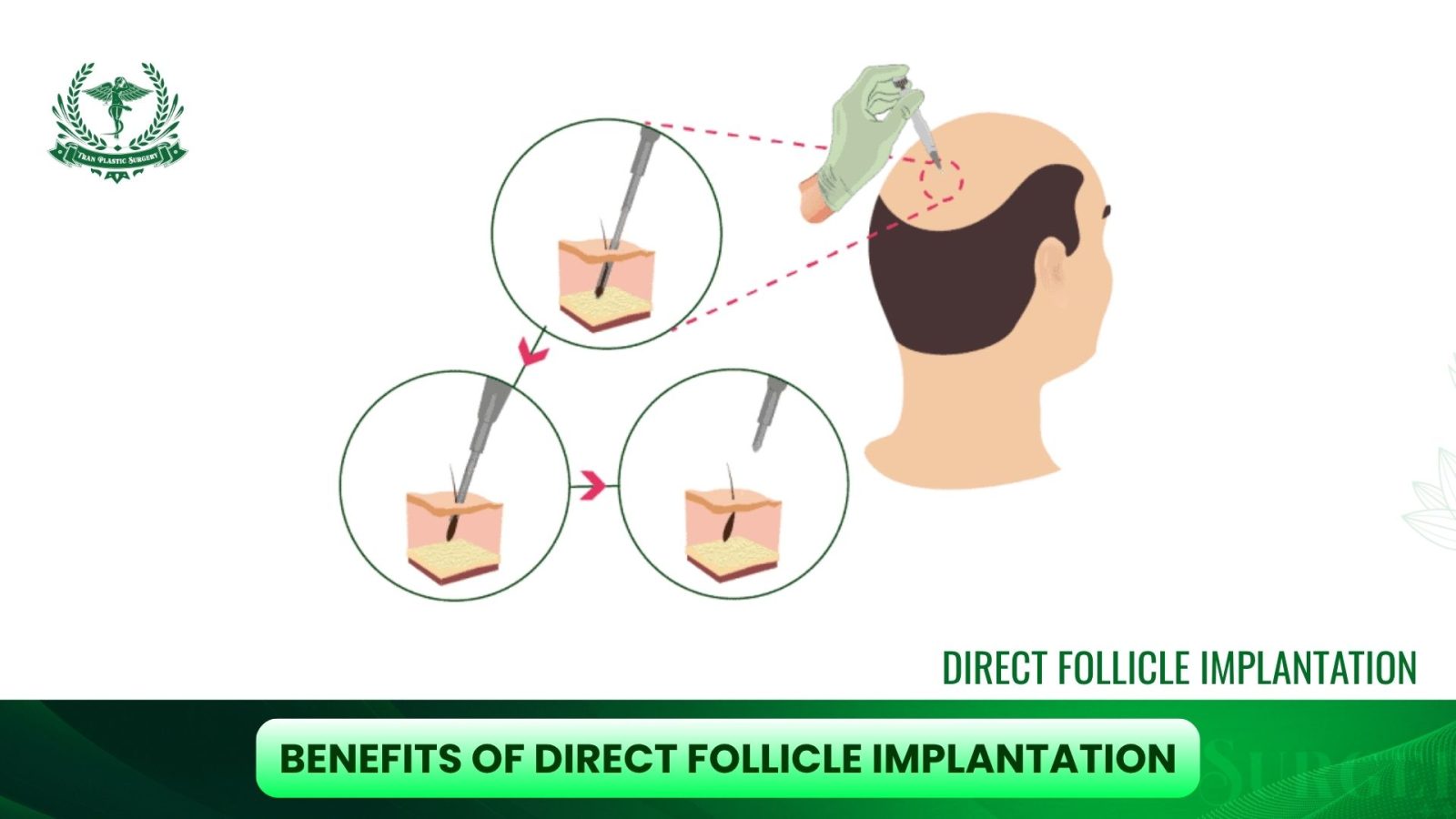
DFI vs. Other Hair Transplant Methods
| Technique | FUT (Strip Method) | FUE (Follicular Unit Extraction) | DFI (Direct Follicle Implantation) |
| Donor Extraction | Strip of scalp removed | Individual follicles | Individual follicles |
| Scarring | Linear scar | Tiny dot scars | Minimal, nearly invisible |
| Implantation | Requires incision slits | Requires incision slits | Direct implanter pen (no slits) |
| Graft Survival | 70–80% | 85–90% | 95–98% |
| Recovery | 2–3 weeks | 7–10 days | 3–5 days |
| Density | Moderate | High | Very High |
Costs of Direct Follicle Implantation (DFI)
Direct Follicle Implantation (DFI) is an advanced hair restoration technique that generally commands a higher price point than traditional FUE or FUT. This premium pricing is due to the method’s complexity, the specialized DFI implanter pens used, the extended procedure time, and the necessity for a highly trained and specialized medical team.
Understanding the cost requires looking beyond a single flat fee and analyzing the primary influencing factors.
1. The DFI Price Structure
The cost of DFI is typically determined in one of two ways:
- Per-Graft Pricing: This model charges a set fee for every follicular unit (graft) transplanted. For DFI, this price is usually higher than for FUE due to the technical precision required. In high-cost regions (like the USA, Canada, or Western Europe), the per-graft cost for DFI often falls between $5 and $10 USD.
- Flat-Fee or Package Pricing: This is common in medical tourism destinations and often includes the entire procedure regardless of the exact number of grafts (up to a certain limit), along with additional services.
2. Global Cost Comparison (Estimated Average Range)
Geographic location is arguably the largest variable impacting the final price. The price difference between Western clinics and medical tourism hubs can be significant, even for procedures requiring the same number of grafts (e.g., 4,000 grafts).
| Region/Country | Estimated Total Cost Range (USD) | Notes |
| United States & Western Europe | $8,000 – $18,000+ | Higher operating costs, surgeon fees, and medical overhead. |
| Australia/Canada | $9,500 – $19,000+ | High standards of care with similar high costs to the US. |
| Turkey (Medical Tourism Hub) | $2,500 – $5,000 | Frequently offered as all-inclusive packages (surgery, hotel, transfers). |
| India/Thailand | $3,000 – $6,000 | Competitive pricing due to lower cost of living and medical expenses. |
*Note: These figures are estimates for a typical procedure (2,000–4,000 grafts) and may vary widely based on the specific clinic and patient needs.
3. Key Factors Influencing DFI Cost
When calculating the final cost of a DFI procedure, patients should consider the following variables:
- Number of Grafts Required: The extent of hair loss is the main driver of cost.
- Mild Hair Loss (1,000–1,500 grafts): Lowest overall cost.
- Moderate Hair Loss (2,000–3,000 grafts): Mid-range cost, common for frontal and crown thinning.
- Severe Hair Loss (3,500+ grafts): Highest cost, requiring the longest surgical time.
- Surgeon Expertise and Clinic Reputation: Highly experienced, board-certified surgeons specializing in DFI/DHI techniques, and clinics with state-of-the-art facilities, typically charge a premium.
- Package Inclusions: Many clinics bundle complementary services into the price. These may include:
- Post-operative care and medications.
- Follow-up consultations.
- Platelet-Rich Plasma (PRP) therapy sessions.
- Accommodation and airport transfers (especially common for international patients).
- The DFI Technique: DFI is inherently more time-consuming than standard FUE because it requires the precise preparation and placement of each follicle using the specialized implanter pen, leading to a higher labor and equipment cost.
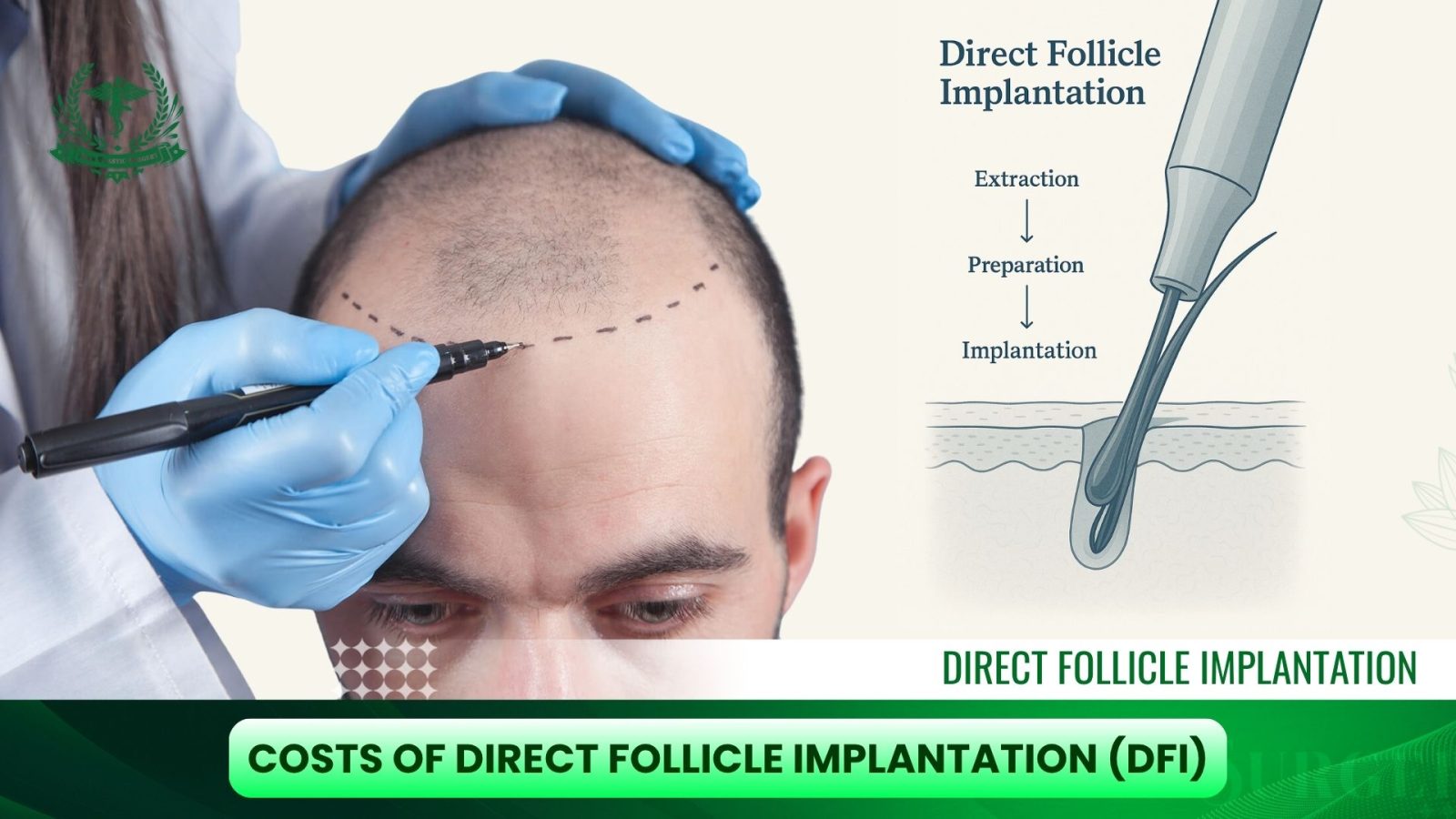
Book your hair implantation consultation at Tran Plastic Surgery today and take the first step toward natural, lasting results.
Recovery After DFI
One of the major reasons patients choose direct follicle implantation over older hair transplant methods is the smoother and quicker recovery process. Unlike FUT, which requires stitches and leaves a linear scar, or even standard FUE, which can result in more visible scabbing, DFI is minimally invasive and has a far shorter downtime. Most patients are able to return to work and daily activities within a few days.
1. Typical Recovery Timeline
Day 1–3: Mild redness and swelling
After surgery, the scalp may appear slightly red or swollen, especially in the implanted area. This usually subsides within a few days. Most patients feel well enough to resume work, light walking, or desk jobs by the third day.
Day 5–7: Scab formation and healing
Small scabs form around each implanted follicle as part of the body’s natural healing process. These scabs typically fall off on their own within a week. Patients are advised not to pick or scratch them to avoid dislodging grafts.
Week 2–4: Shedding phase
Some of the transplanted hairs may shed a completely normal and temporary stage known as “shock loss.” The follicles themselves remain intact beneath the skin, ready to produce new growth.
Month 3–4: New hair growth begins
Fresh, permanent hair starts to emerge. At this stage, growth is often fine and soft, but it gradually thickens over the following months.
Month 9–12: Final results
By the end of the first year, patients can expect to see their full, natural results. Hair density, thickness, and texture will continue to improve, blending seamlessly with the surrounding hair.
2. Post-Operative Care Guidelines
Proper aftercare plays a huge role in ensuring that your transplanted follicles survive and thrive. Surgeons usually provide detailed instructions, but common recommendations include:
- Avoid strenuous activities for 7 days – Heavy exercise, weightlifting, or bending over may increase blood flow and disrupt healing.
- Sleep with the head elevated – For the first 2–3 nights, using two pillows or a recliner helps reduce swelling.
- Gentle washing routine – Patients are instructed on how to wash the scalp without disturbing the grafts. Specialized shampoos or sprays may be provided.
- No scratching or rubbing – Itching is common as the scalp heals, but scratching can damage follicles.
- Limit sun exposure – Direct sunlight on the scalp should be avoided for at least a few weeks.
- Attend follow-up visits – Regular check-ups with the surgeon ensure proper healing and allow early detection of any issues.
*Expert Note: Dr. Tuan Tran (Tran Plastic Surgery) explains that while recovery is generally fast, each patient’s healing process is unique. “Following post-operative care instructions carefully is just as important as the surgery itself. Patients who protect their grafts in the first week often enjoy better density and more reliable long-term results.”
Is DFI Right for You?
Choosing a DFI hair transplant is a significant decision. It’s often an excellent choice if your hair loss is mild, or if you want to restore a smaller, specific area like your hairline with high precision. DFI is also ideal if you desire a natural-looking outcome and prefer a minimally invasive procedure with a quick recovery.
However, be aware that it can be more expensive than other methods. The best way to determine if DFI is right for you is to have a thorough consultation with a qualified hair transplant surgeon who can assess your specific condition and discuss your goals.
Expert Opinion – Dr. Tuan Tran, Tran Plastic Surgery
Dr. Tuan Tran, founder of Tran Plastic Surgery, is widely recognized as a leading expert in advanced hair restoration methods, including direct follicle implantation (DFI). With years of experience in both reconstructive and cosmetic surgery, Dr. Tran has helped countless patients regain not only their hair but also their confidence.
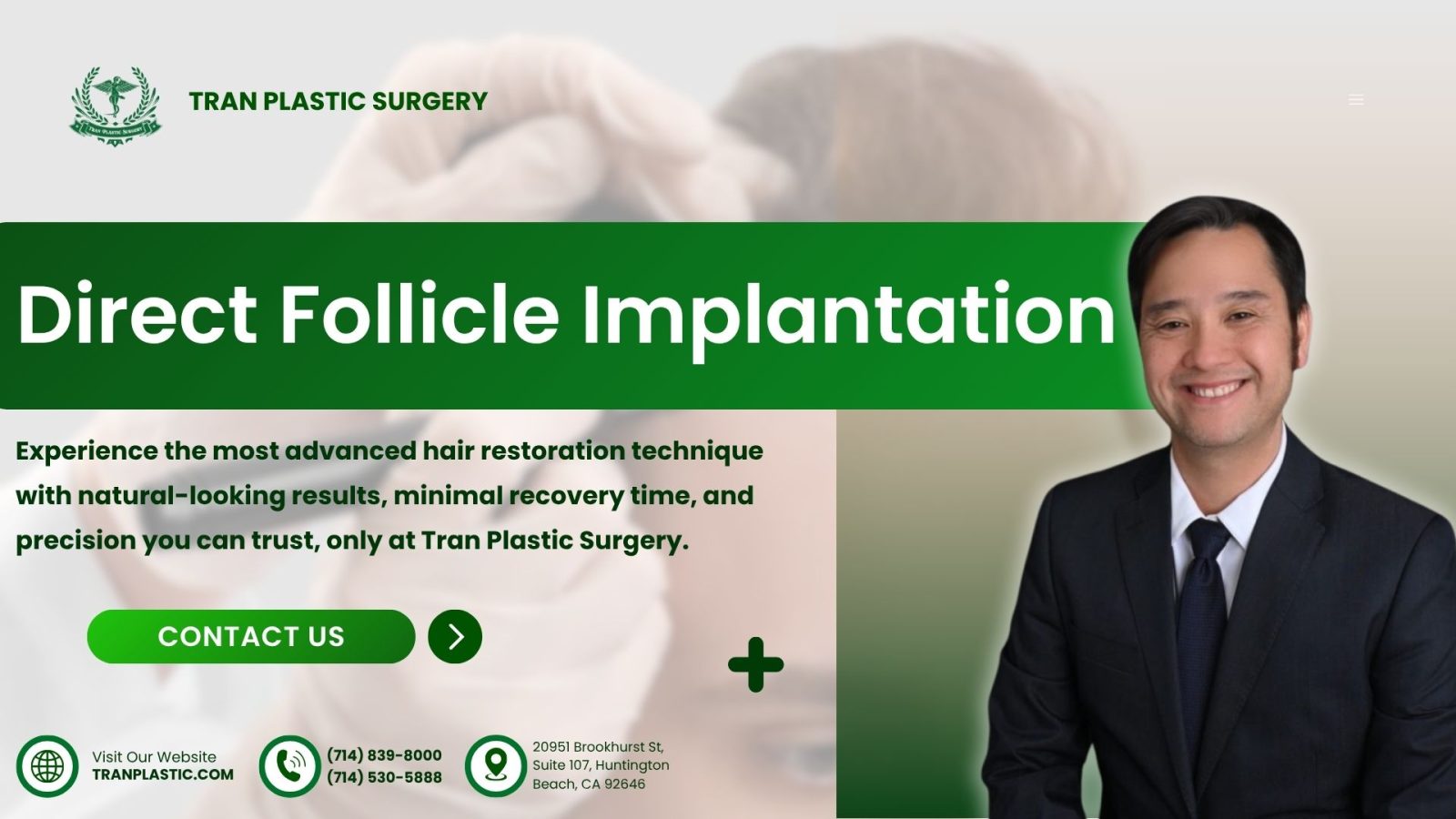
According to Dr. Tran:
“Direct Follicle Implantation represents the cutting edge of hair transplantation. It’s not just about restoring hair but restoring confidence. For patients who want the most natural, scar-free, and permanent solution, DFI is an outstanding choice.”
What sets Dr. Tran’s approach apart is the combination of state-of-the-art tools, advanced graft preservation techniques, and artistic precision. His clinic uses the latest implanter pen technology to maximize graft survival, while also focusing on creating a natural hairline that complements each patient’s unique facial structure.
Patients at Tran Plastic Surgery benefit from:
- High success rates – thanks to meticulous follicle handling and implantation techniques.
- Natural-looking results – designed to match the patient’s age, hair type, and density goals.
- Comprehensive care – from initial consultation through recovery, with personalized post-operative support.
For individuals considering direct follicle implantation, Dr. Tuan Tran emphasizes the importance of choosing a skilled surgeon and a clinic that prioritizes both technology and artistry. At Tran Plastic Surgery, the goal is not just hair regrowth, it’s a lifetime of renewed confidence.
Conclusion
Direct Follicle Implantation (DFI) is redefining the hair transplant industry by combining precision, density, and minimally invasive techniques. With higher graft survival rates, faster recovery, and natural results, it has become the preferred choice for patients seeking premium hair restoration solutions. If you are considering a hair transplant, consulting an experienced surgeon like Dr. Tuan Tran at Tran Plastic Surgery can help determine whether DFI is right for you.

